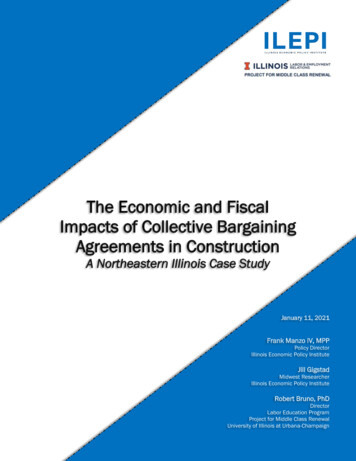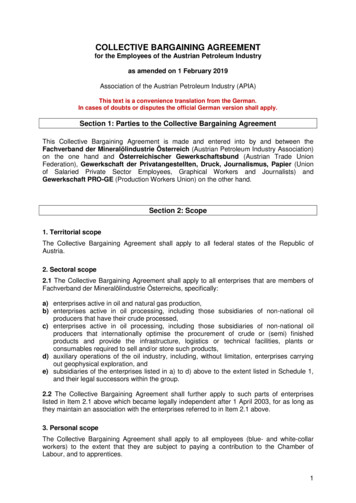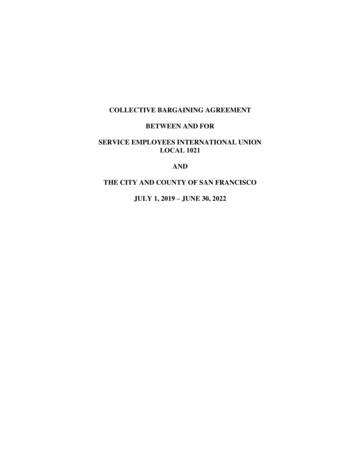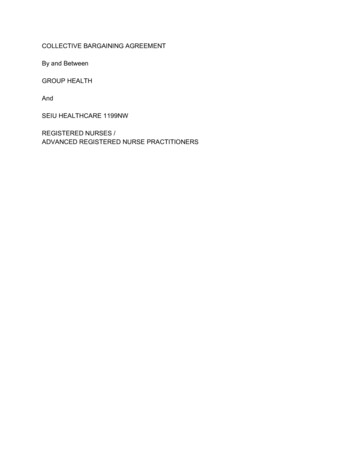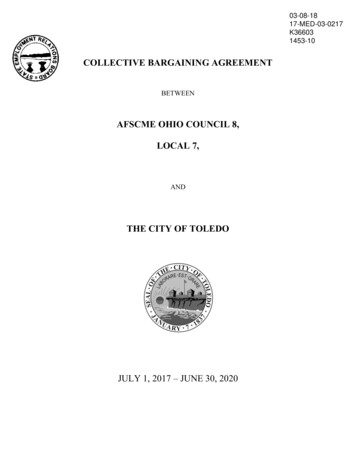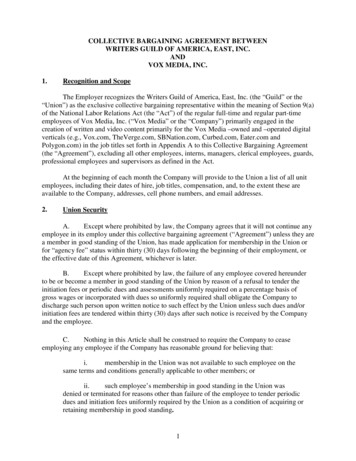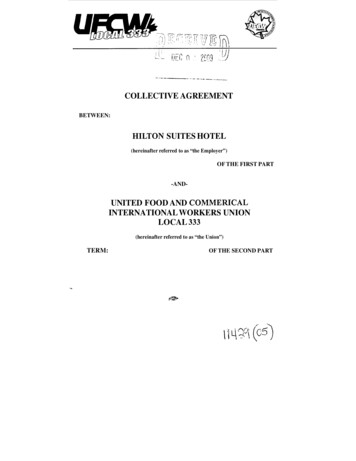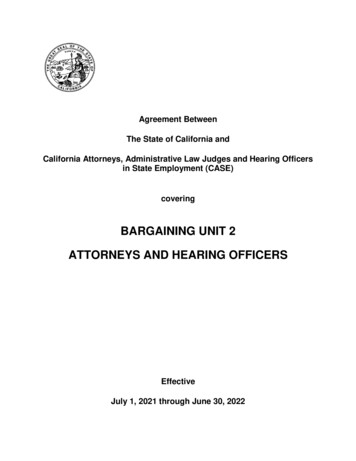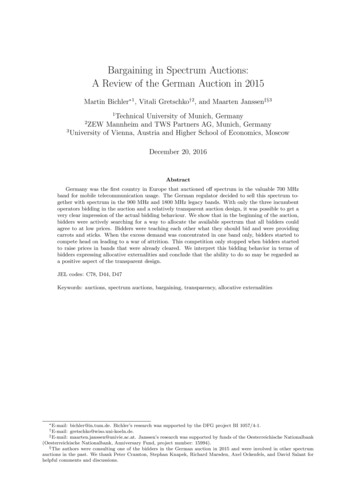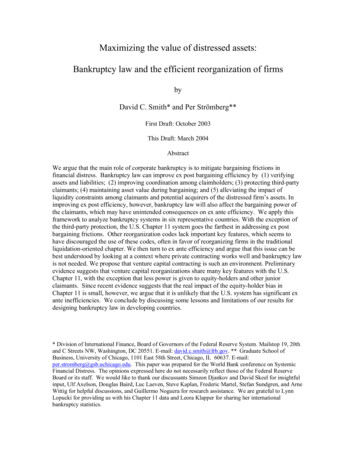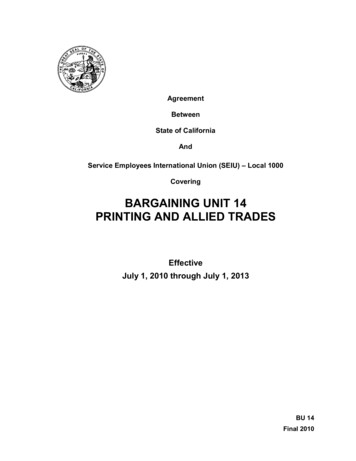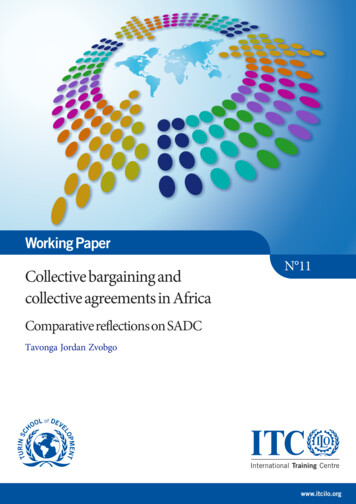
Transcription
Working PaperCollective bargaining andcollective agreements in AfricaN 11Comparative reflections on SADCTavonga Jordan ZvobgoInternational Training Centrewww.itcilo.org
International Training Centre of the International Labour OrganizationViale Maestri del Lavoro, 1010127, Turin, Italywww.itcilo.orgThe Working Paper of the Turin School of Development is part of a wider effort by the InternationalTraining Centre of the ILO to contribute to the development policy dialogue through a widedissemination of the research findings of its staff, postgraduate course participants, partner institutionsand external collaborators. Papers are selected for publication on the basis of originality, technicalsoundness and policy relevance.This paper was originally written by Mr Tavonga Jordan Zvobgo under the supervision ofMr Giuseppe Casale, during his internship with the Turin School of Development of theInternational Training Centre of the ILO.Copyright International Training Centre of the ILO, 2019.Materials in this publication may be freely quoted or reprinted with proper acknowledgment andreference to the document.Publication in the Working Paper of the Turin School of Development does not preclude the authorfrom subsequently publishing the papers in peer-reviewed journals, books and elsewhere.Suggested citation for this paperZvobgo, T.J. 2019. Collective bargaining and collective agreements in Africa. Turin School ofDevelopment Working Paper No. 11. International Training Centre of the ILO, Turin, Italy.DisclaimerThe designations employed in this publication and the presentation of materials do not imply theexpression of any opinion whatsoever on the part of the International Training Centre of the ILO or itspartner institutions concerning the legal status of any country, area or territory or of its authorities, orconcerning the delimitation of its frontiers.The responsibility for opinions expressed rests solely with their authors, and publication does notconstitute an endorsement by the International Training Centre of the ILO or its partner institutions ofthe opinions expressed in them.Reference to names of firms and commercial products and processes does not imply their endorsementby the International Training Centre of the ILO or its partner institutions, and any failure to mentiona particular firm, commercial product or process is not a sign of disapproval.i
COLLECTIVE BARGAINING AND COLLECTIVEAGREEMENTS IN AFRICACOMPARATIVE REFLECTIONS ON SADCTavonga Jordan Zvobgaii
IntroductionEvery individual has the right to work with dignity, regardless of their gender or sex, race, tribe,geographical place of origin, socio-political, legal and/or economic status. To this end theinternational conventions and norms are of great significance in not only protecting this recognisedbasic human right but in the formulation of standards to ensure employees work with dignity. 1 Itis axiomatic that being able to provide a balance to the demands of the worker while at work andfinding new and better ways to manage people, time, space and workloads effectively is crucial. Inorder to not only protect the right to work with dignity but to find better ways to manage people’swork effectively, several means, such as collective bargaining and the judiciary can be put intoservice.The work of the judiciary is of paramount importance to the protection of labour rights. Acompetent, independent and impartial judiciary is important for the implementation of these rightsand the proper administration of justice. 2 The judiciary aids in interpreting and applying nationalconstitutions and legislation in harmony with International Labour Standards (ILS) and customaryinternational law. 3 It also clarifies ambiguity or uncertainty in domestic law and develops thecommon law in light of the values and principles enshrined in international human rights law. 4 Thejudicial community, however, is often marred by demonstrably erroneous judgments cloaked inrationale based on either outdated or biased legal, political, moral and social principles. This hasaffected the nature and extent that people enjoy their rights and freedoms and has been a keyinterest of civil society groups such as Amnesty International, 5 ActionAid6 and Save the Children 7amongst others. Due to this, the world of work cannot divorce itself from such precedent, ratherit can learn and improve.In recent years, there has been more movement of capital than labour across international borders.As a result the judicial community has had to turn more from what their respective domestic laws1 Labour rights are human rights. Thus any blatant disregard of one’s labour rights is an infringement of their inherent humanrights.2 The Bangalore Principles of Judicial Conduct, 2002 (The Bangalore Draft Code of Judicial Conduct 2001 adopted by the Judicial Group onStrengthening Judicial Integrity, as revised at the Round Table Meeting of Chief Justices held at the Peace Palace, The Hague, November 25–26, dicial./Bangalore principles.pdf (accessed 13th June, 2019)3 Customary International Law refers to the body of law which is accepted as applying universally and is generally regarded asincluding the fundamental freedoms and human rights. It apply within a country regardless of whether there has been a ratificationand/or incorporation of a convention.4 Bangalore Principles of Judicial Conduct, 20025 See www.amnesty.org6 See www.actionaid.org7 See www.savethechildren.net1
prescribe and consider using international human rights instruments and ILS 8 in their ratiodecidendi and in aiding/ guiding common law where local legislation is silent. Thus, increasedawareness amongst the judiciary and within the legal fraternity has become crucial in order tostrengthen the role of judges, lawyers and legal educators in promoting social change. 9Cheadle 10 notes that, “Fundamental human rights, which include the core international labourstandards, are inherent in all human beings and find expression in international human rightsinstruments, national constitutions and legal systems throughout the world.” 11 Continuing withthis, Cheadle remarks:“The use of international labour standards in domestic law must however be based on the legal materialsavailable to a court under its domestic law. Those legal materials are: international customary law and thepossibility of common law incorporation; the constitution and the manner in which it articulates withinternational law, statute and the common law; and the common law itself, including principally its rulesof interpretation. In whatever way international labour standards are applied, the standards provide a richand authoritative source for the development of labour law at the municipal level, ensuring consistencybetween the different systems of law while at the same time ensuring state compliance with internationalobligations.” 12The International Labour Organization (ILO) has three conventions linked to the right to bargaincollectively. 13 These are, Freedom of Association and Protection of the Right to OrganiseConvention, 1948 (No. 87), Right to Organise and Collective Bargaining Convention, 1949 (No.8 International Labour Standards are legal instruments drawn up by the ILO's constituents (governments, employers andworkers) and setting out basic principles and rights at work. They are either Conventions (or Protocols), which are legally bindinginternational treaties that may be ratified by member states, or Recommendations, which serve as non-binding guidelines. Inmany cases, a Convention lays down the basic principles to be implemented by ratifying countries, while a relatedRecommendation supplements the Convention by providing more detailed guidelines on how it could be applied.Recommendations can also be autonomous, i.e. not linked to a Convention. nd-recommendations/lang-en/index.htm (accessed 16th June, 2019)9 Thomas, C., Oelz, M., & Beudonnet, X., “The Use of International Labour Law in Domestic Courts: Theory, Recent Jurisprudence, andPractical Implications”, in Les Normes Nternationales Du Travail: Un Patrimoine Pour L'avenir: Melanges En L'honneur DeNicolas Valticos [International Labour Norms: A Heritage For The Future: Essays In Honor Of Nicolas Valtcos] 249 (JeanClaudejavillier & Bernard Gernigon Eds. 2004) (Fr.)10 Cheadle, H. (2012). Reception of International Labour Standards in Common-Law Legal Systems. Acta Juridica, 2012, 348-364.11 Ibid, pg. 34812 Ibid, pg. 36413 The ILO has eight core conventions. The eight ILO fundamental Conventions are: the Forced Labour Convention, 1930 (No.29), the Abolition of Forced Labour Convention, 1957 (No. 105), the Freedom of Association and Protection of the Right toOrganise Convention, 1948 (No. 87), the Right to Organise and Collective Bargaining Convention, 1949 (No. 98), the EqualRemuneration Convention, 1951 (No. 100), the Discrimination (Employment and Occupation) Convention, 1958 (No. 111), theMinimum Age Convention, 1973 (No. 138), and the Worst Forms of Child Labour Convention, 1999 (No. 182). These coreConventions are binding on the member states irrespective of whether or not they have been ratified or not. https://www.ilo.org(accessed 16th June, 2019)2
98) and Collective Bargaining Convention, 1981 (No. 154). There are however complex issueswhich arise from these three conventions linking the concept of collective bargaining with otherconventions, such as equality and non-discrimination, 14 the right to work and free choice ofemployment, 15 minimum age for admission to employment and work, 16 the worst forms of childlabour, 17 and decent work for domestic workers. 18In Africa, legal frameworks such as the African Charter on Human and Peoples’ Rights 19alsoaffirms the right to free association. Under Article 15 20 of the Charter, every individual has theright to “work under equitable and satisfactory conditions” 21which can be achieved throughcollective bargaining. Whilst most of the African countries have either legislation or Constitutionthat commit to collective bargaining, the levels of implementation differ as per the levels ofpolitical development or prevailing economic condition of the country and the involvement of theinternational donor community. The important thing to note, however, is that collective bargainingprovides sufficient amplitude to compass all the facets of working with dignity under any economicconditions.In addition to this, there are several issues that have become increasingly important over the pastfew years such as the rise in the informal workforce, technological advancement, occupationalhealth and safety, training and skills development, migrant workers and the policies adopted bydeveloping countries when dealing with emerging economies such as Brazil, China and India. 22These are among some of the issues that shall be discussed in this paper with particular bias beingon their impact, in Southern Africa, to the rights of both workers on the one hand and employerson the other hand to bargain collectively. This paper will also manoeuvre on a human centredapproach in a world fast advancing and replacing the human element in the field of work.It is logical to presume, prima facie, that worker’s rights are going to be encroached directly by thetechnological advancements the world of work will experience in the future. With regard to thepossibility of mass retrenchments, or the closure of the business due to the assimilation of theseArticle 2, Universal Declaration of Human Rights (UDHR), 1948Article 23, Universal Declaration of Human Rights (UDHR), 194816 Minimum Age Convention, 1973 (No. 138)17 Worst Forms of Child Labour Convention, 1999 (No. 182)18 Domestic Workers Convention, 2011 (No. 189)19 African Charter on Human and Peoples’ Rights (also known as the Banjul Charter), 1981, Article 1020 African Charter on Human and Peoples’ Rights, (1981)21 Ibid, Article 1522 Susan Hayter discusses five emerging economies - Brazil, China, India, South Africa and Turkey in, Hayter. S. and Lee, C. H.(2018) Industrial Relations in Emerging Economies: The Quest for Inclusive Development. Edward Elgar Publishing. Cheltenham, UK. ILO:Geneva.14153
technological advancements, the Committee on Freedom of Association stated that this “shouldnot in itself result in the extinction of the obligations resulting from collective agreement, inparticular as regards compensation in the case of dismissal.” 23 Whether or not this is true remainsto be proved but it is beyond the scope of this paper. Its focus, regarding the future of work willbe focused on southern Africa’s development and will show that other than a slight time lag,experiences in southern Africa, or Africa as a whole, parallel those of other countries.This paper also limits its scope to country–level & regional collective bargaining developments andpractices from southern African countries, namely Botswana, Malawi, South Africa and Zimbabweall of which have ratified ILO Conventions No. 87 and No. 98 but not No. 154. 24 It will make useof Committee of Expert’s reports on these countries, decided judgments from these jurisdictions(both reported and unreported), current legislation and other sources as well. Reference is madeto case law from these countries to aid the discussion and to also further demonstrate that impactof the judiciary as an essential element to the protection of human rights and labour rights.In the next section, the nature and function of collective bargaining will be discussed as a usefulbackground and context to key issues addressed in this paper. Reference will then be made toInternational Labour Standards (ILS), and in descending order to regional agreements in Africaand brief reflections of the same in the European Union. Additionally, reflections are made tocorporations which operate in more than one country and to Transnational Company Agreements(TCAs). It has to be recognised that there is no legal enforcement mechanism in place for TCAsbut they serve to promote key features of the respective national models of social dialogue andcooperative industrial relations in the countries they affect. Finally attention will shift to theparticular countries within the SADC region that form the focus of this paper.Freedom of Association – Sixth Edition, (2018) para 1515Ratifications of C154 – Collective Bargaining Convention, 1981 (No. 154)https://www.ilo.org/dyn/normlex/en/f?p 1000:11300:0::NO:11300:P11300 INSTRUMENT ID:312299 (accessed 11th June,2019)23244
Part 1What is Collective Bargaining?Collective bargaining is a crucial form of social dialogue. 25 Its true nature recognizes “thedesirability for joint decision making, joint problem solving and joint responsibility in conductingrelations between employers and employees.” 26 In addition, it is a key method used to regulate therelationship between management and employees in the workplace and a means to settle disputesthrough joint decision making. The true value of collective bargaining is that it generally producespeace within the enterprise, provides a level playing field between parties and preserves the essenceof freedom of association. 27 In other words, collective bargaining and freedom of association aremutually reinforcing such that neither is fully realized without the other.The Interacting PartiesAccording to the ILO Collective Bargaining Convention, 1981 (No. 154), collective bargainingrefers to “all negotiations which take place between an employer, a group of employers or one ormore employers' organisations, on the one hand, and one or more workers' organisations, on theother, for: (a) determining working conditions and terms of employment; and/or (b) regulatingrelations between employers and workers; and/or (c) regulating relations between employers ortheir organisations and a workers' organisation or workers' organisations.” 28 The ILO definessocial dialogue as “all types of negotiation, consultation or simply exchange of informationbetween, or among, representatives of governments, employers and workers, on issues of commoninterest relating to economic and social policy.” 29 It can be among bipartite parties in the workplace(between labour and management) or industrial sector (between trade unions and employers’organizations) or by tripartite parties (with government as an official party to the dialogue) atnational or regional levels. It is crucial to note that “collective bargaining is a fundamental rightaccepted by member States from the very fact of their membership in the ILO, and which they25 Non – standard Workers: Good Practices of Social Dialogue and Collective Bargaining/ Minawa Ebisui. International Labour Office, Industrialand Employment Relations Department. – Geneva: ILO, 2012 (Working paper No. 36) ublications/WCMS 179448/lang--en/index.htm (accessed 13th June, 2019)26 Collective Bargaining and Labour Disputes Resolution; is SADC Meeting the Challenge? /Fumane ‘Malebona Khabo. ILO SubRegional Office for Southern Africa, Harare: ILO, 2008 (Issue Paper No. 30) blications/WCMS 228800/lang--en/index.htm (accessed 26th June, 2019)27 Freedom of association is “a basic human right with universal scope enabling the enjoyment of other rights, a process withsubstantive content, and opens the door to participatory actions against forced labour, the protection of children from abuses andresponsive measures based on non – discriminatory and equality beneficial to all.” Giving Globalization a Human Face. InternationalLabour Conference 101st Session, 2012. Report III (Part 1B). ILO: Geneva https://www.ilo.org/wcmsp5/groups/public/--ed norm/---./wcms 174846.pdf (accessed 13th June, 2019)28 Article 2, International Labour Organization Convention No. 15429 ILO, Areas of work – Social Dialogue ialogue/lang--en/index.htm(accessed 13th June, 2019)5
have an obligation to respect, to promote and to realize in good faith.” 30 Importantly, the ILOrecognises social dialogue and/or collective bargaining as a standard which promotes social justiceand peace, fair workplace relations and decent work, sustainable development, social and politicalstability.LimitationsOne of the objectives of workers in exercising their Convention No. 87 rights to organize is tobargain collectively, for instance through worker organisations, their terms and conditions ofemployment 31– to the extent that these are not fixed by law – or improving on legal minimumstandards. 32 Limitations (or exceptions) of this right have only been acknowledged for certaingroups of public servants such as armed forces, the police and public servants engaged in theadministration of the State. 33 Whilst this may be so, this exception or limitation leaves intact therights guaranteed to public servants under Convention No. 87.It is agreed that, in practice, “priority should be given to collective bargaining as a means to settledisputes arising in connection with the determination of the terms and conditions ofemployment” 34 not only in the private sector but also where it concerns the public servants whoare not engaged in the administration of the State. A distinction therefore needs to be madebetween public servants who by their functions are directly employed in the administration of theState and all other person employed by the government, public enterprises or by autonomouspublic institutions, who should benefit from the rights enshrined in Convention No.98. 35Collective bargaining therefore applies to all workers, irrespective of their type of employment,including the following categories of workers: prison staff, fire service personnel, subcontractedworkers, rural and agricultural workers, workers in export processing zones (EPZs), migrantworkers, seafarers, apprentices and domestic workers.Existing FormalitiesGenerally there are no formalities to how the negotiations should be conducted or what should beproduced as a result of the same. It is for the parties negotiating to determine the subjects forILO Declaration on Fundamental Principles and Rights at Work, 1998, para 2Freedom of Association. Compilation of decisions of the Committee on Freedom of Association / International Labour Office – Geneva: ILO,6th edition, 2018. Para 123432 Fact sheet No. 1. (2015) Collective Bargaining. International Labour Office www.ilo.org/collectivebargaining (accessed 11th June,2019)33 Ibid, para 123934 Ibid, para 124135 Giving Globalization a Human Face. ILC (2012), para 17230316
negotiation. 36 However, the subject for negotiations typically include “the type of agreement to beoffered to the employees or the type of industrial instrument to be negotiated in the future, as wellas wages, benefits and allowances, working time, annual leave, selection criteria in case ofredundancy, the coverage of the collective agreement, the granting of trade union facilities,including access to the workplace beyond what is provided in legislation.” 37 In so far as theduration of the collective agreement is concerned, this again will be a matter for the party’sinvolved 38taking cognisance of issues such as the workers’ genuine interests and any statutoryprovisions.At the end of the negotiation process, a collective bargaining agreement (also known as a collectiveagreement) is produced, outlining the conditions agreed to and any limitations with regards totime. In certain jurisdictions, such as South Africa (to be discussed below) the only formality for acollective agreement is that it should be reduced to writing. 39This is in line with the CollectiveAgreements Recommendation, 1951 (No. 91) which states that collective agreements are, “allagreements in writing 40 regarding working conditions and terms of employment concludedbetween and employer, a group of employers or one or more employers’ organisations, on the onehand, and one or more representative workers’ organisations, or, in the absence of suchorganisations, the representatives of the workers duly elected and authorised by them inaccordance with national laws and regulations, on the other.” 41 Absent of being in writing, boththe Recommendation and South African authorities consider any agreed terms and conditions tobe a mere gentleman’s agreement and therefore only persuasive (even with ipsissima verba), unlessby operation of legislation – such as the Labour Relations Act (hereinafter also referred to as LRA). 42In addition to being in writing, some jurisdictions go further and require the collective agreementto be registered with the Minister responsible for labour or employment for it to be recognised.In other words, the collective bargaining agreement (hereafter also referred to as the CBA) is thetail end or brainchild of collective bargaining and a direct result of the expression of an individualworker’s enjoyment of their freedom of association rights. It is the end result of open and friendlynegotiations or when employers and employees meet together and talk over their commonFreedom of Association – Sixth Edition, (2018) para 1289Ibid, para 129138 Ibid, para 150239 Bhoola U. (2002) National Labour Law Profile: South Africa. national-labourlaw-profiles/WCMS 158919/lang--en/index.htm (accessed 10th June, 2019)40 Labour Relations Act, 66 of 1995 (s213)41 Freedom of Association – Sixth Edition, (2018) para 134442 66 of 199536377
interests openly and freely. But for the success of such negotiations, the employers and employeeswould come to a stalemate which could often result in either strike action or employees workingwithout a contract for a length of time. 43It is important to associate collective bargaining and CBAs with the insight of the ILO Committeeon Freedom of Association who states that the “collective agreements should be binding on theparties.” 44This view is taken particularly because when parties bargain, it involves a process ofgive–and–take and “a reasonable certainty that negotiated commitments will be honoured, at thevery least for the duration of the agreement, such agreement being the result of compromises madeby both parties on certain issues, and of certain bargaining demands dropped in order to secureother rights which were given more priority by trade unions and their members.” 45 It wouldtherefore defeat the purpose if the agreements were not binding on the parties in the first instance,secondly, if the parties did not voluntarily enter negotiations, 46 and lastly if they did not bargain ingood faith. 47What is Collective Bargaining? ective-bargaining/ (accessed 10th June,2019)44 Freedom of Association – Sixth Edition, (2018) para 133445 Ibid, para 133746 Ibid, para 131347 Ibid, para 1328438
Part 2Transnational Labour Relations: The Case of SADCThere are different levels upon which collective bargaining is undertaken that have an impact onlabour relations, employers and employees and even the state. The determination of the bargaininglevel is essentially a matter to be left to the discretion of the parties. 48 In practice, it could either beat the level of the branch of activity or at the enterprise level, industry level, central or inter–occupational level, national level (with government as an employer & as a member of the TripartiteSystem), regional level (like EU or SADC) or at international level. 49 Undeniably, the use ofinternational labour instruments / standards by courts in both monist and dualist legal systems inevery jurisdiction around the world has the potential of strengthening domestic judicial decision–making 50 regardless of the level of negotiations.It is important to note that the prevailing system of incorporation of international law in domesticlaw, either monist or dualist, influences the way in which international labour instruments can beused in and by domestic courts. It has been argued that dualist systems carry an advantage overmonist systems due to their “application of common law not embodied in statute but insteadevolved by interpretation in the courts.” 51 This allows for international labour standards to be usedand accepted by way of judicial precedent. Based on this analysis it is apparent that transnationallabour relations will also be affected by the prevailing system of incorporation.According to one school of thought, “the degree to which courts refer to international instrumentsis considerably determined by the prevailing legal culture with regards to openness and awarenessof international law rather than the system of incorporation.” 52In many instances, awareness thatthe use of international standards in national courts will not circumvent the national legislation butwill rather enrich and improve domestic judicial decision-making is sine qua non.The current members of the Southern African Development Community (SADC) are: Angola,Botswana, Comoros, Democratic Republic of Congo, Kingdom of Eswatini (Swaziland), theKingdom of Lesotho, Madagascar, Malawi, Republic of Mauritius, Mozambique, Namibia,Article 4 of Convention 98Freedom of Association – Sixth Edition, (2018) para 140450 Thomas et al (2004) pg. 25351 Layton, R. (2006). When and how can Domestic Judges and Lawyers use International Law in Dualist Systems? International Training Centreof the ILO – Turin: ITCILO, 2006 (accessed 28th May, 2019)52 Ibid, pg. 28348499
Seychelles, Republic of South Africa, United Republic of Tanzania, Zambia and Zimbabwe. 53SADC adopted a Social Charter 54 in 2003 whose overall objective is to facilitate through close andactive consultations amongst social partners, a spirit conducive to harmonious labour relationswithin the region. 55 This is a bold move towards the establishment of minimum regional standardswhich are paramount when undertaking transnational collective bargaining with SADC-widecompanies. If the European Union is taken as an example, one would note that an acceptable andmutually agreed upon regional system of transnational labour relations and standards can be ofbenefit to the people in the SADC region. However, there are scholars who believe that SADC isa toothless body and thus any such system within the SADC region in particular is but a fleetingdream. 56Taking into account the foregoing, one way to create transnational or regional labour standardswithin SADC is to ensure the application or implementation of international labour standards setby the ILO. 57 Another measure argued by Smit 58is the empowerment of local actors in the memberstates of the SADC. Whilst this may certainly contribute towards the establishment of regionallabour standards for SADC, it does not take into account the different politico-economic climateswithin the member States. Such climate can hinder the operations or integration of the saidstandards. An example would be the politico-economic climate and ever growing “informaleconomy” 59 in Zimbabwe.Focusing any standards without incorporating those workers in the informal economy wouldtarnish the effectiveness of the system. The informal economy, amongst other things, ischaracterized by serious decent work 60 deficits which include absence of social protectioncoverage, poor health and safety, long working hours, weak labour inspection and lack of socialSouthern African Development Community (SADC), https://www.sadc.int/member-states/ (accessed 16th June, 2019)Charter of the Fundamental Social Rights in SADC, 2003 (the Social Charter of the Fundamental Social Rights in SADC2003.pdf (accessed 16thJune, 2019)55 Ibid, Article 256 Smit, P. (2014) “Transitional Labour Relations in SADC: A Dream or Possibility in SADC?”
collective agreements in Africa Comparative reflections on SADC Tavonga Jordan Zvobgo N 11. i . /Bangalore_principles.pdf (accessed 13. th. June, 2019) 3 Customary International Law refers to the body of law which is accepted as applying universally and is generally regarded as
